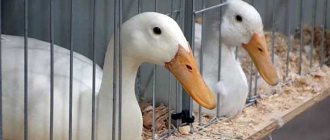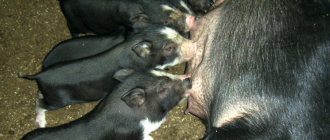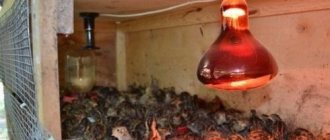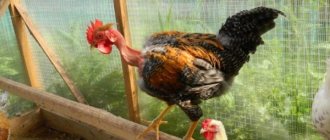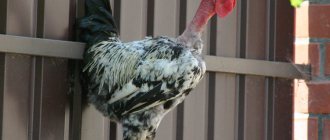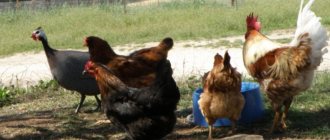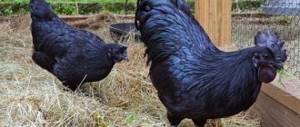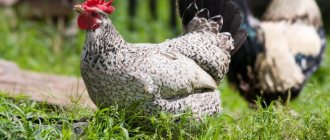Proper mating and farrowing of Vietnamese pigs are the key to successful breeding of these animals. The strong immunity of pot-bellied piglets is developed at an early age, so the birth process must take place in full compliance with veterinary standards. For mating, you need to use proven breeding boars, and for farrowing, you need to provide the sow with the most comfortable conditions.
Early maturing pigs with a calm character
Pot-bellied piglets are characterized by early puberty and already at the age of 3.5-4 months the future sow is ready to reproduce. However, a young pig at this age continues to develop into an adult animal. Therefore, experienced livestock breeders do not recommend covering a Vietnamese pig until it reaches a weight of 30-35 kg.
It is possible to determine that a female has entered the hunting period by external signs. She loses her appetite, becomes restless, the genital loop area swells and periodic mucus is noticeable.
If you lightly press on the back of a pig in heat, it stops moving and freezes in place, demonstrating its readiness to copulate. If such signs appear, you should not delay it and you need to let the breeding boar approach it.
How to tell if a Vietnamese pig is pregnant
Unlike the Pietrain and Landrace breeds, the sow and boar of the Vietnamese breed are ready for mating at 3 months. But experienced farmers say that the first mating is best done at 5-5.5 months, as with conventional breeds. Read about how many days a pig walks in this material.
Despite early sexual maturity, the older the pig, the easier the birth. Also, the percentage of healthy offspring obtained increases with age.
Signs of pregnancy and pot-bellied pigs
Gynecological signs by which the breeder understands that fertilization was successful:
- The sow calms down, is more passive and good-natured.
- A sharp weight gain begins, shapes become rounded.
- The animal constantly carries straw in one place, as if building a nest.
- The nipples swell and turn red. If you gently press on them, a clear liquid appears - colostrum.
- After intercourse, an ordinary pig will notice a re-inclination within 2-3 weeks. The absence of this is another sign of pregnancy.
- White, porous discharge can sometimes be seen on the genitals.
A rapid increase in muscle mass helps determine that the female is preparing for childbirth and feeding her offspring. All of the above signs signal the owners that the pig is ready to farrow.
How many months does a pregnant woman carry her offspring?
In terms of the duration and course of pregnancy, Vietnamese pigs are not much different from ordinary pigs. The simplest way to call time in obstetrics is 3 triplets: 3 months, 3 weeks, 3 days. In more precise terms, from 114 to 120 days. The period varies depending on the number of cubs being carried, the weight of the pig, the type of pregnancy and other gynecological factors.
The rapid birth process is preceded by prolapse of the abdomen, clear separation of cotyledons, and the restless nature of the animal.
Number of piglets
It is difficult to predict how many offspring a sow will give birth to. As a rule, during the first pregnancy there are about 5 piglets, then the numbers vary from 9 to 14 per farrowing.
Use multiple manufacturers
Mating of Vietnamese pigs is quite easy. To do this, you need to lock the female and the male in a separate pen and give them the opportunity to spend 1-2 days together. This time will be quite enough to cover. No assistance from the livestock breeder is required in this process.
For many years, experts involved in pig breeding claim that pregnancy is easier, and stronger offspring are born, if the females are successively covered by several wild boars, the number of which should not exceed three.
To exclude the possibility of obtaining non-viable offspring, it is necessary to use boars that are not related to the female for mating.
If pregnancy does not occur, then after 22 days the female will begin the hunting period again. In this case, it is necessary to cover it with a boar that did not take part in the previous mating.
How to properly maintain it?
When breeding Vietnamese pot-bellied pigs, it is recommended to follow the rules and regulations to ensure the maintenance necessary for Vietnamese piglets:
- A pigsty for this breed should be made of brick or wood with concrete floors and a drain for flushing out waste.
- There should be dry straw on the floor.
- Vietnamese pot-bellied piglets do not like drafts, so cracks in the walls must be sealed, if any.
- In winter, it is better to install wooden flooring (platform) on the floor; they occupy approximately 2/3 of the area in each individual cage. The pigs rest and sleep on the platform, and eat and defecate on the concrete. In such conditions, the weight of the animal remains stable.
- Ceilings must be at least 2 meters.
- It is better to make the size of the pen area up to 4.5 meters; 2 single pigs or a sow with cubs can fit here.
- Boars love space; they need an area of at least 3.5 m2.
- There must be ventilation in the pigsty. In winter, high-quality heating should be provided; you can use a gas convector, a stove, or something else that provides heat.
We recommend reading: Forvet - instructions for using drops and immunomodulator
In addition, it is recommended to make a pool where the piglets will swim and a platform where they will walk. It should be noted that in spring and summer, piglets need to walk for a long time. The walking area should be equipped with a mud bath. It is done simply: dig a hole measuring 2 x 2 meters wide and 30 cm deep and pour water into it.
Piglets of this breed love to bathe, and baths provided in this way protect Vietnamese piglets from overheating in the sun and insects. It’s good if there are a couple of trees on the site, the pigs will rub their backs against them. Otherwise, you can put logs, just dig them well into the ground. In addition, proper maintenance of Vietnamese pigs requires the installation of a canopy from the sun and rain on the site.
Know how to use a farrowing chart
Due to the fact that Vietnamese pot-bellied pigs are capable of producing offspring twice a year, the owner of a small farm needs to adjust his plans by purchasing the required amount of feed right before the farrowing period.
In order to find out the approximate farrowing time of a sow, experts have compiled the table below.
It is very easy to use. You just need to combine the mating date with the month of the year and you can find out the approximate farrowing date of your pig. This will provide an opportunity to prepare for childbirth and conduct it at the highest level.
Farrowing chart:
Keeping Vietnamese piglets: what to feed an Asian pig?
Nutrition is an important component of breeding Asian pigs, on which the quality of meat depends. The pot-bellied pig has a slightly different food digestion system than the regular pig. They have a small stomach and small intestine. Food enters the stomach quickly.
All feeds that have a coarse grind, hard straw, fodder beets, whole cereal grains - all this is poorly digested in the stomach of an Asian pig.
Since Vietnamese pigs are a herbivorous breed, the proper feeding of the animal is hay made from herbs such as:
- clover;
- frog;
- alfalfa;
- sweet clover;
- goat's rue
Many vitamins necessary for pigs of this breed are contained in such products as:
- pumpkin;
- apples;
- pears;
- zucchini;
- carrot.
These vegetables and fruits should not be cooked; it is better to give them raw. Boiled potatoes can be given along with mixed feed; it is better to cook them at once (it is not recommended to store them). Feed must contain:
- 40% barley;
- 30% wheat;
- 10% corn, peas and oats.
We recommend reading: Ultrasound of cats
A large amount of corn affects the pig’s parameters: the animal’s weight rapidly increases, so there is no need to give it a lot.
During one feeding, an adult pig, as a rule, eats 700 grams. compound feed. You should not allow it to overeat, otherwise the meat will not be as tasty, and overeating is bad for the pig. In summer and spring, pigs need to eat more fresh grass, and feed is only 20% of the total diet per day. You need to feed in the morning and evening. But in winter and autumn, compound feed should make up 30% of the total diet. Breeding animals of the Vietnamese breed should include the addition of the following components to the basic diet:
- hay;
- different types of grain (ground);
- mash with bran.
It is necessary to feed three times a day. In addition, it is recommended to add vitamins and food additives to the food of Vietnamese pigs.
If the pig is fed correctly and in a timely manner, it will have tasty, juicy meat and lard. The piglets will gain weight well and also look good.
Pregnancy proceeds without complications
Pregnancy in pot-bellied sows in most cases proceeds without complications. Pregnant pigs bear offspring for 114-118 days.
If the mating was carried out correctly, then within a few days pregnancy will occur and the pig’s habits will change. She will stop freezing when she feels pressure on her back and will not show signs of sexual seeking. She will begin to eat a lot and rapidly increase in size, becoming taller and larger than the other piglets in her brood.
In the first three months of pregnancy, the sow's belly hardly grows, and only in the last month before giving birth will it grow rapidly.
While expecting offspring, pigs need to be fed intensively so that the expectant mother accumulates more fat deposits. Pot-bellied pigs stop eating a lot just before giving birth, showing increased anxiety.
Table of introduction of complementary foods and norms of weight gain by age
The process of weaning babies from their mother should be spread out over several days. So the sow will not be able to develop mastitis, and the piglets will feel good. At the age of forty days, you can give preventive vaccinations to Vietnamese piglets
against helminths with brovandazole and others.
Raising and fattening Vietnamese pot-bellied
pigs
can be a very profitable venture for a farmer. But to achieve this, of course, you need to plan everything, soberly assess your capabilities and prepare to devote time and attention to your wards. Only if you have all of the above can you expect a good return from this interesting, but painstaking activity.
Signs of imminent labor
If the female is pregnant, she will spend a lot of time in her pen, accumulating strength before giving birth. The pig eats a lot and grows quickly. Within a month she becomes taller and larger than other animals from her litter, and in the last month her belly begins to actively grow.
Now we will tell you how to determine the approach of labor if you did not use the table above. This period has clear visible signs:
- the pig does not allow humans to approach it, becoming overly aggressive;
- her appetite sharply worsens;
- the animal begins to arrange the nest, thoroughly chewing the litter;
- the stomach drops;
- you can see enlarged nipples and swollen genitals.
If colostrum begins to leak from the nipples, then this is the first sign of impending labor, which can occur within the next 12-16 hours.
Farrowing of Vietnamese pigs
About a couple of days before farrowing, the sow begins to worry, her belly drops, lobes form, her nipples turn red and swell. If, when pressing on the nipple, drops of translucent colostrum are released, then we expect labor within the next 24 hours. On the day of farrowing, the sow prepares the nest very carefully and responsibly; she crumples the bedding and chews the hay to make it softer.
If the sow refuses to eat, then this is a sure sign of the imminent onset of labor, which must be met fully prepared. It is necessary to clean the machine from sawdust and anything foreign, leaving only hay and a drinking bowl with clean water. It is necessary to fence off a corner for the piglets, bring a red lamp to it to maintain the optimal temperature, prepare diapers, threads for tying the umbilical cord, scissors, and cotton wool with an iodine solution.
Some breeders of Vietnamese pigs claim that sows do not need assistance during childbirth, I strongly disagree with this for many reasons. The sow, under the supervision of the owner, will feel calmer, and childbirth will proceed faster and easier.
Childbirth usually lasts 3 - 5 hours, in rare cases up to 12. labor ends with the release of the placenta, which usually consists of two parts. The afterbirth must be carefully collected and removed, thereby preventing the sow from possibly eating it.
Prepare the birthing area independently
It is traditionally believed that pregnancy and childbirth in the Vietnamese pot-bellied pig proceed smoothly, since its body constitution fully complies with the standards of the wild.
Under normal conditions, the sow independently carries, gives birth and cleans her piglets, allowing them to her breast. But farrowing pigs at home requires human participation.
Having noticed signs of an approaching period of labor in a Vietnamese pig, the owner of a pig farm should carefully prepare for them by cleaning the pen. You can add some fresh hay, which the sow will arrange herself in the way that suits her.
If farrowing occurs during the winter months, it is necessary to provide heating for the maternity room. When keeping piglets normally, the temperature in the pigsty should be about + 20 degrees Celsius, and during farrowing it should be raised to 32 degrees. To do this, you can use a red lamp, the light of which can be directed at the babies and the adult pig.
In most cases, childbirth takes place in the evening and at night. They can last up to 5 hours, and it is best for the farmer to stay near the pig all this time, providing all possible assistance.
Vietnamese pot-bellied piglets
Newborn piglets should receive a portion of colostrum within the first hour of life (twenty to forty minutes). The fact is that piglets are born with a small supply of nutrients, and if they do not receive mother's milk on time, they may die.
So, the born piglet must be cleaned of films and mucus, especially carefully clearing the airways (piglet and mouth).
At a distance of 2-3 fingers from the tummy, we tie the umbilical cord with threads and cut it off. We treat the wound with iodine solution and place the pig under a lamp to dry. The temperature in the first days of life should be maintained at 30°-32° C. At lower temperatures, piglets' thermoregulation is impaired, they develop worse and get sick. In the first day of life, piglets suckle from their mother every 25 to 40 minutes, so it is very important to monitor the quantity and quality of feeding of each piglet so that there is no developmental delay in the future.
At birth, piglets have two pairs of baby teeth in each jaw, for a total of eight. The teeth are placed in such a way that when sucking they cover the nipple from all sides and help the piglets in the feeding process by holding the tongue. Therefore, I strongly recommend not removing baby teeth from piglets. Teeth are removed only if they are placed incorrectly in the mouth. But such cases are very rare. Towards the end of the first month of life, the sow's milk production decreases. By this time, the piglets should learn to feed themselves. Gradually I begin to separate the piglets from the sow. Doing this in stages, over five to six days. I do not recommend abruptly weaning piglets; it is harmful for both the piglets and the sow. The mother may develop mastitis, and the children may experience stress, loss of appetite and indigestion.
At the age of forty days, we give the piglets prophylaxis against helminthic infestations. From an early age, piglets should be taught to walk in the fresh air. At the beginning for a few minutes, then increasing them to several hours (in the warm season).
Preparing for farrowing
Having determined by external signs that a pot-bellied pig is about to farrow soon, the farmer must immediately prepare for it. In addition to the mandatory cleaning of the maternity area, care should be taken to create a separate nest for piglets. You can make separate boxes with soft hay bedding. The water in the drinking bowl needs to be replaced, which should not only be purified, but also slightly heated.
You need to prepare an improvised first aid kit. It should definitely include clean towels or diapers, scissors, thread, cotton wool, and iodine. There should be a sufficient amount of heated water at the ready.
Usually the first time farrowing a Vietnamese pig is the most difficult. To stimulate labor, it is recommended to give the young sow an injection with the hormonal agent Oxytocin . The animal must be thoroughly washed with soapy water, paying special attention to the belly and nipples.
Each subsequent birth will be easier because with age the pig becomes stronger, more experienced and less panicky.
Farrowing process
Signs of labor
You can tell that a pig will farrow soon by its behavior. A few days before giving birth, even the calmest pig can rush around the pigsty, gnaw on hay bedding, or, conversely, sharply alternate between increased activity and rest.
A few hours before birth, the following signs appear:
- The abdominal cavity descends, the deflection in the lower back increases.
- The female begins to get nervous and often lies down on the floor.
- The udder becomes very large and colostrum is released from the nipples.
- Breathing quickens.
- Amniotic fluid begins to be released.
Most often, labor begins with attempts at intervals of 4-5 minutes. During this period, the animal breathes especially heavily and lies on its side almost motionless.
How does the first farrow go?
Normally, a first-time mother's babies are born within six to seven hours. Sometimes the process can last up to eleven hours. If the attempts are weak, you can give the pig warm water and gently massage the abdomen. Each baby takes between twenty minutes and half an hour to be born.
Childbirth technique
To make the task easier for the sow, you need to be present at the birth and take part if necessary.
It is necessary to thoroughly wash your hands up to the elbows, wipe them with an antiseptic, put on rubber gloves and a clean apron.
The birth bladder most often ruptures during passage through the birth canal. If this does not happen, the person needs to break the bubble themselves so that the baby does not suffocate. If the piglet is not breathing, you need to give it a chest massage or put it in warm water to provoke the start of respiratory activity.
Newborns should be wiped of mucus with a clean towel or diaper. It is equally important to remove mucus from the mouth, ears and nasal cavity. The umbilical cord needs to be tied with a thread, cut off and treated with brilliant green or iodine. Newborn piglets should be placed in a warm nest prepared in advance.
It is advisable to have a veterinarian present at the first birth of a pig. But if this is not possible, you can call an experienced pig breeder.
Sometimes the piglet moves very slowly through the birth canal. If the process is delayed, you need to help the woman in labor. It is advisable to treat even a clean glove again with a gentle antiseptic and anoint it with Vaseline. You need to carefully insert your hand into the vagina and feel the fetus. It is allowed to pull the pig out only with the start of a new attempt. If everything went well and the baby was born, you need to rupture the birth bladder, wipe the newborn dry and cut the umbilical cord.
If the placenta does not come out for a long time, you need to call the veterinarian!
Possible problems
During the first farrowing in life, as a rule, disturbances in labor are more often observed. It is necessary to closely monitor the woman in labor to prevent the death of the mother and offspring.
Large piglets
The large size of the fetus is dangerous for domestic pigs, especially if farrowing occurs for the first time. In this case, if the female cannot give birth for a long time, you need to urgently call a veterinarian to save the sow and piglets from death.
Wrong location
This scenario is the most dangerous. Often with this arrangement, the cubs are born dead. Sometimes they can die long before birth, provoking the development of inflammation and death of the pregnant female.
If the birth proceeds relatively normally, but after feeling the piglet, the breeder realizes that the fetus is not positioned correctly, you should urgently seek qualified help from a veterinarian.
Stillborn babies
In some cases, a dead piglet may become stuck in the birth canal. If you cannot get the baby yourself, you need to contact a veterinarian. Any disturbance during the birth process, especially aggravated by the death of piglets, can cost the life of the sow.
Prolonged labor
As in previous cases, you need to call a veterinarian so that in addition to the piglets, you do not lose their mother. If labor continues for more than twelve hours, you cannot do without qualified assistance.
Babies should be given mother's colostrum immediately
Childbirth begins with periodic contractions. They pass with an interval of 8-10 minutes, after which they turn into attempts. Amniotic fluid comes out of the genital organ.
The babies are born one after another, and it is necessary to promptly select them from their mother, who may inadvertently crush one or more piglets.
Each baby is born in its own fruit sac. The film must be removed, after which you need to wipe the baby dry.
Piglets immediately after birth begin to look for the mother's breast and are obliged to gain access to it as quickly as possible.
Vietnamese pot-bellied pigs have excellent innate immunity, which is developed in the first hours of life along with maternal colostrum. If you do not allow the piglet to leave the pig's teat in a timely manner, the animal may subsequently be severely weakened and often get sick.
It is believed that in order to obtain immunity, each piglet must receive a portion of maternal colostrum within half an hour after birth. Therefore, they need to be brought to the nipples, even if the birth process continues.
House in the village
The question of whether a Vietnamese pot-bellied pig should be helped to give birth, or whether it can do everything on its own, often causes disputes between breeders.
I am inclined to believe that normally Vietnamese pot-bellied sows do not need the help of their owners. The situation when a person must interfere with the labor of a multiple-fetal animal is atypical, and I cannot classify such births as normal.
Below there will be photos of some moments of farrowing, if you are not interested in viewing them, do not open them.
The exterior of the Vietnamese pot-bellied pig is close to the wild, for example, to the exterior of a wild boar, therefore, labor in the vast majority of cases proceeds well.
In my opinion, there is such a pattern - the closer the skeletal structure of a domestic animal is to its wild variation, the easier the birth is. In animals with multiple births, childbirth is also easy due to the small size of the cubs, but the greater their number, the longer the birth lasts, and their well-being begins to depend on the endurance of the female.
On average, farrowing does not last more than 5 hours. During this time, the pig manages to produce from 4 to 15 cubs. There are record-breakers who give birth to more than 20 piglets, but such fertility, in my opinion, is a disadvantage: the cubs do not have enough nipples, the extra piglets have to be transferred to artificial feeding, given to another pig or destroyed.
The breeding age of Vietnamese pot-bellied pigs is 5-5.5 months with a weight of 35 kg. When choosing the time for the first mating, you need to start not from age, but from weight, and here’s why.
During pregnancy, the young pig continues to grow, sometimes even outstrips its peers in height, and after giving birth, when the piglets are fed milk, the pig does not grow, but only loses weight. If by the end of pregnancy she has not gained the required muscle (not fat!) mass, then during the period of feeding the piglets (about 1.5 months) the pig will lose a lot of weight and will take a long time to recover; the time of the next mating will have to be postponed, which is not something most pig breeders profitable. It is better not to take or leave poorly growing small pigs for breeding.
Some pig breeders allow two boars in turn to approach the pig during one hunt, supposedly to increase the quantity and quality of piglets. If the farm positions itself as a breeding farm, such an approach is unacceptable. The resulting offspring will come from different fathers, for example, 7 piglets from the first and 2 from the second, or in any other ratio. It is unrealistic to sort piglets by father without genetic testing. Breeding work involves strict accounting of parents and offspring, and it is clear that such shuffling of boars in breeding is unacceptable.
The duration of pregnancy in Vietnamese pot-bellied pigs is about 115 days, or, simply put, three months, three weeks and three days (three hours and three minutes, as jokers add).
Signs of impending childbirth in gynecology are called harbingers.
The harbingers of labor in a pig are as follows: the abdomen noticeably drops, the mammary glands and external genitalia swell. This usually occurs between a week and four days before delivery.
On the day of birth, the pig prepares the nest. She collects everything that is nearby, for example, bedding, branches, sticks and boards, her bowl, everything that she can tear off the walls. The type of nest will depend on the abundance of bedding and the diligence of the pig. I read about a case where a pig put various old iron and nails in a nest. At this moment, there is no need to skimp on hay or straw, I throw in more soft bedding, the pig will grind it into dust and make a lush, warm nest.
My pigs have so far all farrowed in the evening or at night.
Having given birth to a piglet, the pig can stand up, but the umbilical cord breaks. The piglet is born in a film that easily breaks itself. The baby crawls out of the film and crawls towards the nipples.
The interval between piglets is from 5 to 30 minutes.
I have never seen a pig lick a newborn.
During birth and for some time afterwards, the pig trembles violently. I understand that this is a normal occurrence for them.
Once born, the piglets begin to poke their muzzles and hooves into their mother’s belly.
They are not yet ready to eat, the sucking reflex has just begun to start, but with these actions the piglets stimulate the labor of the mother. It is believed that they should start eating no later than half an hour after birth. I never worry about this. My piglets do not begin to suckle their mother before an hour later, and confidently attach themselves to the nipples only a few hours after birth. A pig normally produces colostrum before or during farrowing.
Often during childbirth, the pig stands up, turns around and lies on its other side.
At the end of childbirth, the afterbirth appears, also known as the placenta.
After the birth of the placenta, farrowing is considered complete. I never remove the afterbirth right away; I give the pig the opportunity to eat it. She is an omnivore, there will be no harm from eating, and the hormonal component of the placenta stimulates milk production.
If I make it to the end of farrowing, then I give the pig water without cold water, and if the birth took place at night without me, then I give water in the morning. Usually, after giving birth, the pig refuses to eat, or eats, but not much.
In case of unforeseen complications, I keep a certain supply of medications and other supplies for obstetrics, but so far I have not needed them.
Possible complications during farrowing
Sometimes the piglet is unable to free itself from the amniotic sac and may suffocate. Therefore, human help will be very helpful. The farmer must clear the mucus from the mouth, nasal openings and ears, and thoroughly wipe the baby with a towel or diaper.
If the newborn does not show signs of life, there is no need to despair. Quite often it is possible to bring him back to life with the help of artificial respiration and chest compressions. However, this must be done extremely carefully so as not to break the pig’s fragile bones.
During a protracted labor process, when babies do not leave the mother’s body for 5 or more hours, you should immediately call a veterinarian. The specialist will be able to give professional advice and help during childbirth, including the use of injections that enhance labor activity.
If this is not done, then you can lose not only the piglets, but also the sow herself.
Possible complications
Most often, the birth process in Vietnamese pigs occurs without dangerous consequences. But the owner of the animals needs to be prepared for some complications. Common problems that occur after farrowing:
- rapid labor can cause vaginal rupture;
- Dry labor occurs when the membranes rupture prematurely. To facilitate labor, warm solutions (flaxseed decoction, vegetable oil, petroleum jelly) are injected into the birth canal;
- The placenta usually comes out 1.5-3 hours after birth. If this does not happen, it is recommended to seek help from a veterinarian;
- uterine prolapse. The pathology can be corrected manually - the organ is disinfected and carefully adjusted. But it is advisable to invite a specialist;
- improper positioning of the fetus can cause strong contractions and prolonged pushing. In such a situation, there is a danger of uterine rupture. To correct the position of the fetus and facilitate childbirth, a veterinarian is invited.
See also
Causes and symptoms of African swine fever, danger to people and how it is transmittedRead
If the situation is not critical, you can help the animal yourself. But with complex farrowing, you cannot do without the help of a specialist. Otherwise, there is a possibility of serious consequences or even death of the sow.
Going out needs help
Sometimes the veterinarian is not able to quickly arrive when called, and the farmer needs to provide assistance to the sow himself. The genital organ is treated with soap, which increases glide and simplifies the farrowing process.
It is required to put on sterile rubber gloves, pre-treated with an antiseptic. Having felt the body of a stuck piglet in the birth canal, you need to begin to gently pull it out without making sudden movements.
Even one baby incorrectly positioned in the birth canal can create serious problems for the female. But when the first piglet is born, the birth process accelerates significantly, and the babies begin to be born one by one.
But even when using absolutely sterile instruments, the female can get an infection, which will be difficult for the body weakened by childbirth to fight. Therefore, after the female has completely farrowed, it is recommended that she be given an injection of a broad-spectrum antibiotic.
Protect from mother's aggression
The Vietnamese pig is a very strong animal that can behave unpredictably during farrowing. Usually during childbirth, sows are calm, but sometimes they can become more aggressive, provoked by pain.
After farrowing, the pig becomes hysterical and may attack the piglets. There are cases where females deliberately crush their cubs or kill them. To avoid this, babies should be selected from such a mother, and she herself is usually discarded after the first birth.
Experts say that after farrowing, the woman in labor needs to create the most comfortable conditions possible, make sure that she is warm and comfortable. There should always be an abundance of warm, purified water in the drinking bowl. “Vietnamese” dogs have an excellent appetite after farrowing. But you need to ensure that the sow eats, and must produce enough milk to feed her babies.
It is best to steam her grain porridges with whole cow's milk or skim milk, which you can learn about in the article “On breeding Vietnamese pigs at home for a beginner.”
Childbirth in Vietnamese pigs at home: signs and care
Childbirth in Vietnamese pigs usually occurs without complications. These animals know how to take care of their offspring, but the presence of a farmer during farrowing is still necessary. It is important to know how to prepare for this event, what conditions need to be created for the newborn and the female, how to care for the uterus and offspring after farrowing. But first you should make sure that the sow is pregnant.
Pregnancy of Vietnamese pigs
How to determine if a pig is pregnant?
Mating of pigs does not always lead to fertilization, but all farmers want to know as early as possible whether the female is pregnant. This can be determined in several ways - with the help of a veterinarian and on your own.
If it is not possible to call a specialist to the farm, observe the sow. Changes in her behavior will tell you whether she is pregnant or not .
Let's consider what signs can be used to determine pregnancy in pigs in the early stages:
- If a female is fertilized, her hormonal levels change, which affects her behavior. The sow becomes calmer, her movements are smooth and careful.
- The animal has an excellent appetite, the female eats more than usual.
- Approximately 5-7 days after fertilization, a cheesy secretion is released from the vagina.
Such diagnostics cannot give one hundred percent confidence in the occurrence of pregnancy, but still it helps many farmers to make a preliminary conclusion regarding the condition of the sow. Clinical studies will be more accurate:
- Rectal examination by a veterinarian.
- Ultrasonography.
- Biopsy.
- Pregnancy test using venous blood.
- Diagnostics with a Doppler device.
The most common method is still a veterinary examination . It allows you to determine pregnancy with high accuracy within 3 weeks after fertilization of the female.
Signs of labor
When the mating has led to the desired result, the sow becomes pregnant, farmers eagerly await the appearance of the offspring. There are many signs by which you can easily determine the approach of farrowing. Let's look at them.
- The sow becomes restless and rushes about.
- About a day before farrowing, the animal begins to arrange a place for the piglets - kneading the bedding and chewing it.
- Her stomach drops.
- The nipples swell a little and become red.
- When you squeeze the nipple, you can see colostrum.
- The animal hardly eats and drinks little.
Reference. Vietnamese sows raised in the wild, sensing the approach of farrowing, try to be closer to people.
Preparing for childbirth
Having noticed at least one of the listed signs of approaching farrowing in a Vietnamese pig, you need to carefully prepare for the birth process. It is necessary to restore order in the room where the animal is kept, to clean the machine from sawdust and litter. Before farrowing, only hay is left and the water in the drinking bowl is changed to clean.
It is important to take care of a separate corner for newborn pigs. Soft bedding is laid there and boxes are installed where the piglets will be placed. If it is possible to connect a red lamp above this place, it is worth doing so.
It will keep babies warm, because up to the age of one week they need a temperature above 30 degrees Celsius.
What should a farmer have on hand when farrowing a Vietnamese sow:
- Scissors.
- Clean towels or diapers.
- Iodine.
- Warm water.
- Threads.
- Cotton wool.
Attention! Experienced farmers recommend purchasing the hormonal drug Oxytocin in time in case the birth turns out to be difficult. Injections with this hormone are administered if labor is weak.
Before the start of labor, the sow is completely washed with soapy water, the belly and nipples are especially carefully treated.
Childbirth process
It is not difficult to determine that labor is beginning - the female is breathing heavily and lying on her side. Contractions can have different durations - from 3 to 10 hours. The first farrow lasts longer than all subsequent ones . When pushing begins, piglets come out of the sow's vagina one by one with a short interval of time.
Each newborn is born in a film that needs to be removed. Then the piglet’s snout and mouth are cleared of accumulated mucus and amniotic fluid. The body is thoroughly wiped with a clean cloth. The umbilical cord is tied and cut at a distance of about 2.5-3 centimeters from the piglet’s tummy. The cut site is immediately treated with iodine. This is done with all piglets.
Attention! Newborns need to receive a portion of colostrum from their mother within 20-50 minutes after birth.
Mother's colostrum contains antibodies and nutrients that will help the little pigs survive. The farmer must try to have time to attach all the piglets to the udder, even if the sow continues to push.
Next, the offspring is placed in a pre-prepared box under a lamp. Babies get very cold because they do not have a layer of fat, like adults. They must be kept at a temperature of at least 30 degrees.
How to attach piglets to the udder after farrowing?
Vietnamese piglets are too slow and have difficulty finding their mother's nipple. The farmer must help the babies get a portion of colostrum. First you need to wipe the udder with a damp, clean cloth and massage it lightly. Massage movements will promote the flow of milk into the glands. Each piglet is carefully brought to the udder and the nipple is directed into the mouth.
Output of placenta
When the placenta comes out, the birth can be considered complete. It is very important to ensure that the placenta separates and exits the sow's birth canal.
Sometimes pigs eat it, but this happens extremely rarely with the Vietnamese breed. The afterbirth must be removed immediately - taken outside and buried.
This is done not only to maintain hygiene rules, but also to prevent the pig from eating the placenta.
Pregnant Vietnamese pig
Complications
Farrowing in Vietnamese pigs occurs easily and quickly, and there are rarely complications after it. However, the farmer should be careful not to lose sight of alarming symptoms. What conditions may occur after childbirth:
- Vaginal rupture. If labor proceeds rapidly, injuries to the vulva are possible.
- Retention of placenta. In pigs, the placenta should be delivered approximately 1-3 hours after farrowing. If this does not happen, the help of a veterinarian is required.
- Uterine prolapse. During childbirth, the reproductive organ may fall out, in which case it must be disinfected and put back in place. It is best to contact the veterinary service.
- Eating the afterbirth. This rarely happens in female Vietnamese breeds, but there is still a risk. If a pig eats the afterbirth, there is a chance that it will destroy its piglets too.
Caring for the uterus after childbirth
The sow is very tired after farrowing. Her heart is working faster and she is thirsty. Immediately after the end of the birth process, you need to give her a liter of water or a mixture of milk and water in the same volume. After 6 hours, you can allow the pig to drink to his heart's content.
Attention! Make sure there is clean water in the drinking bowl. In its absence, the animal’s condition will worsen, milk production will decrease, and the risk of cannibalism will increase - the pig may eat the offspring.
There is no need to rush with the first feeding - no less than 8-10 hours after farrowing, you can offer the animal a third of the norm of liquid oatmeal or bran mash. Such food will help restore water balance and prevent constipation.
The feeding rate is increased gradually, because the abundance of food will provoke active milk production, and newborn piglets will not yet be able to suck out its entire volume. In this case, there is a high risk of developing stagnant processes in the udder.
After about a week, the pig should receive the usual amount of food. Juicy feed is included in the diet on the 4th day after farrowing, and roughage on the 6-7th day.
Starting from 2 weeks, increase the amount of root vegetables in the queen’s diet; they stimulate milk production.

